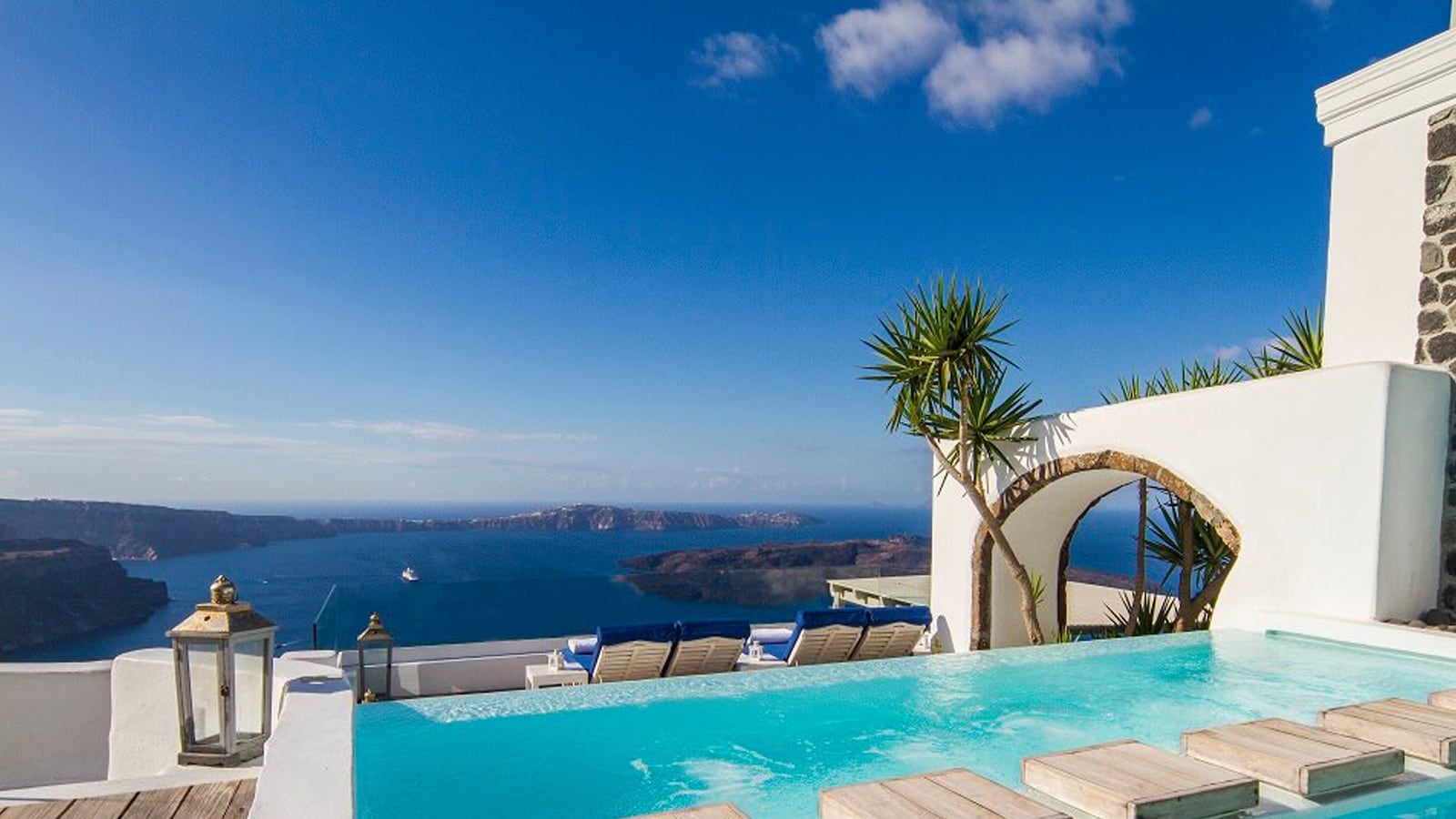It seemed the perfect way to banish the seasonal blues—a few sunny days on Santorini, Greece’s volcanic island. I thought the combination of its whitewashed houses, glittering sapphire sea, and invigorating Cycladean light would cure the effects of a long, rainy English winter and bring my hibernating senses back to life.

So it was a little ironic that as I walk through Santorini’s airport, hailstones as big as olives are drumming on its roof, the wind is howling, and sheet lightning flashes outside. As we drive through Thira, the island’s capital, scooters skid through streams of rainwater.
It is a dramatic beginning. But Santorini has, in its time, known far worse. The largest of an archipelago of islands, Santorini is the vestige of a single volcanic landmass that erupted around 1600 BC. The central area sank and the surrounding sea rushed in; what remained was a large caldera of cliffs, shaped like a crescent moon, around a blue bowl of Aegean water.
It was, in fact, one of the largest volcanic events in human history. Lava and ash fell for days; the sun was obliterated for three months. It is thought that the thermal energy produced by the eruption was up to 10 times more powerful than that of the 1883 eruption of Krakatoa in Indonesia. The vast tidal wave that ensued raced south to the northern shores of Crete and may have led to the collapse of the Minoan civilization.

The Greek archaeologist Spyridon Marinatos discovered that, at the time of the eruption, Santorini housed a flourishing Minoan city-state, named Akrotiri. From layers of white pumice and ash, Marinatos unearthed marble figurines, gold jewelry, pithoi pots, and frescoes depicting early Aegean life: girls gathering saffron, a naked young fisherman with his catch, and a flotilla of sailing boats decorated with swallows and butterflies.
It is an island of legends. The philosopher, Plato, linked Santorini with the mythical lost city of Atlantis that sank beneath the waves. More recently, glass fragments found in the soil of the Nile Delta have given scientists reason to believe that there is a link between the eruption and the darkness described in the Bible at the time of the Exodus from Egypt.
The storm blows over and the sun emerges by the time we reached the village of Imerovigli, set high on Santorini’s northwestern ridge. It is a beguiling group of white cubical houses, windmills, crooked lanes, and blue-domed churches that tumble down the ochre and brown layers of the caldera walls.
Our destination is Iconic Santorini, a newly renovated “cave hotel” with 22 bedrooms dug into the cliffside and fanning out over several interlinking gleaming white stone terraces, one on top of the other. All the rooms are designed in classic Cyclades architecture, but some were constructed out of the original structures built long ago as stables, storage rooms, or the homes for the less well off. A couple of rooms still retain their original features: thick walls, a bread oven, or water cisterns (now converted into grotto pools).
Where the hotel’s infinity pool ends, a 900-foot drop to the sea below begins. Taking in the view is rather like standing on the bow of a vast ship. My gaze wanders from terrace to terrace, absorbing the brightness and whiteness and colors of Iconic Santorini: navy sun beds, pots of scarlet geraniums, blue margaritas, zinc pots of lavender and pewter-green olive trees. Here, at last, is the blast of bold Mediterranean colors I craved. The scent of wild thyme rises on the breeze; tiny seabirds wheel close to the cliff’s layers of ochre rock and black lava. Below lies the turquoise waters of the caldera, flecked with the white triangles of sailing boats. “Here, it’s just you, the cliff and the gods,” said Dimitris, the manager, before ushering me to lunch.

The hotel’s bijou restaurant has the feel of a private dining room enhanced by the “open kitchen” policy, which allows guests to see every olive that’s pitted or baklava that’s baked. Eight courses of an exquisite meze-style lunch emerge: prawns with an out-of-this world sagomaki sauce; mamouri, a soft-white cheese, and fava, the local dish known as “Santorini gold” made from puréed yellow-split peas, mint, almonds, and caramelized onions.
With lunch we drink several glasses of sweet Vinsanto, known by Venetians as Vini di Santorini, which is one of the oldest wines in the world. The island’s hot desert climate means rain is rare, so the thick vines, some of which are hundreds of years old, draw most of their moisture from sea mist. Unusually, the vines are grown in circles close to the ground—known as a koulara—which protects them from the scorching sun and strong northerly winds. Grapes are sun-dried on straw for 10 to 12 days, then aged inside French oak barrels. The most famous white wine grape on the island is the Assyrtiko.
“It was the ancient Greeks who taught the Romans to make wine, who in turn taught the French,” our guide says when later we visit Estate Argyros, a vineyard whose fifth-generation owner is considered a master of Vinsanto. There I try several vintages of the amber-gold wine that tastes of honey, spices, and burned caramel. “This is how we describe the taste of the sun,” our guide explains. It’s small wonder that every Santorini father matures a bottle for his daughter’s wedding. I buy several.
Later that day I walk along the paved path to the island’s capital, Thira. A church bell tolls, an elderly woman in traditional widow’s black walks stiffly along the cobbles, and a weather-lined man emerges from a house, urging his donkey down the steps with a clicking sound. Once in Thira, however, the feel of traditional Greece is diluted by a disappointing network of touristy streets lined with racks of baseball caps and tasseled scarves, kebab shops, Irish bars, and shop after shop selling luminous fluorescent bracelets and cheap pottery.
In search of the more peaceful part of Santorini, I walk north through Imerovigli’s rabbit warren of narrow alleys and along a path lined with sprays of marguerites and poppies, to the conical peninsula of Skaros. A Venetian fortress, or castellos, was built on the peninsula to protect Santorini from the pirates that once roamed the Aegean Sea. From its rocky crown, I have magical views across the caldera to the uninhabited, still-active volcanic islands of Palea and New Kameni, which sometimes exude sulphurous yellow streams into the sea from their active sulphur vents. On the far side of Skaros, I find the peaceful, blue-domed chapel of Panagia Theoskepasti clinging to the cliff’s rocks.
From Skaros it is another three-hour walk to the bohemian village of Oia, another castellos village set high on the northernmost tip of the island. Oia was severely damaged by an earthquake in 1956, then rebuilt following strict rules: all electric cables are fed underground by law, and the center of town is traffic-free. The village is a labyrinthine collection of colors and shapes: pink-and-white houses with arched entrances and rectangular slit windows, S-shaped paths, rounded walls, ornate blue bell towers, and circular windmills. It seems like a place where fairies or hobbits might live.
I walk past art galleries, artisan shops, and tavernas that line the lanes to Oia’s ruined castle, to which hundreds of people flock to feast on the lilacs, yellows, and vermilions of the setting sun and to see the panoramic view of the ocean. On the way to the ruins, I am drawn, like a mortal lured beneath the waves by a Greek Siren, into the fascinating subterranean bookshop, Atlantis. A decade ago, a group of friends from the U.S. and U.K. discovered there was no bookshop on Santorini, so they “drank wine and decided to build one.” Against every wall books are piled from floor to ceiling, including first editions of Truman Capote and Hemingway. It’s an imaginative, quirky venture—a sign over a fur-strewn basket in the corner reads, “rent a cat for £5 an hour,’”and the shop’s “book donkey” regularly trots out of the village, past the church that was built in memory of sailors lost at sea, with its saddle-bag laden with books destined for local schools.
Santorini is an island of churches: nearly 400 of them, many topped with the quintessential blue dome. Most churches are private, built either to give thanks for the recovery of a sick family member…or to avoid paying taxes. One of the most beautiful is the Episkopi Church that stands in the northern foothills of Profitis Ilias, Santorini’s highest mountain. The tiny marble-floored, red-brocaded 12th-century chapel contains beautiful Byzantine frescoes, colored glass bricks, and one of the most valuable icons of its era, the Panagia Glykofilousa—an icon of the Virgin of Tenderness. It was supposedly one of the only items that survived a devastating fire in 1915; legend has it that a hand appeared out of nowhere to protect it from the flames.
I return to the hotel for an Ayurvedic massage in the spa, and another exquisite multi-meze supper, after which I resume my position at the brow of the ship, looking out onto the black abyss. The lights of Thira curve along the caldera rim like a necklace; a new moon illuminates rocky land that slopes dramatically to the black-sand beaches of the leeward shore. I can see why the original name of this mythical island was Kallisti—“the most beautiful one.”






